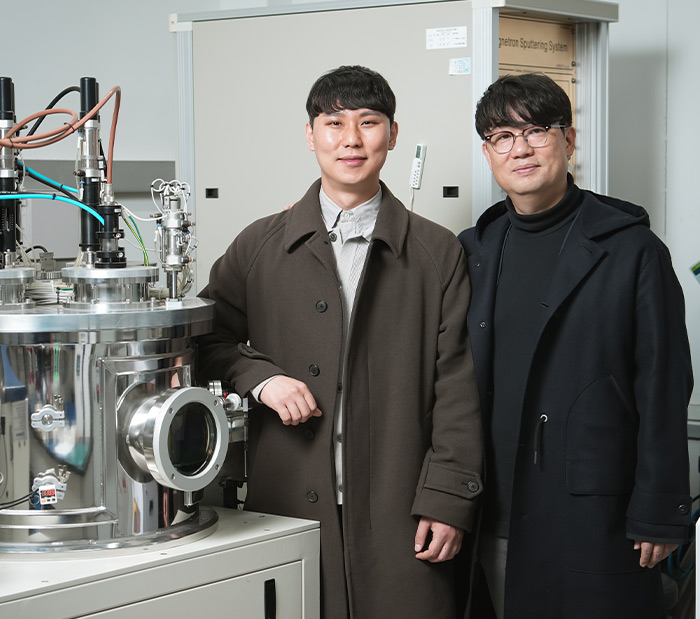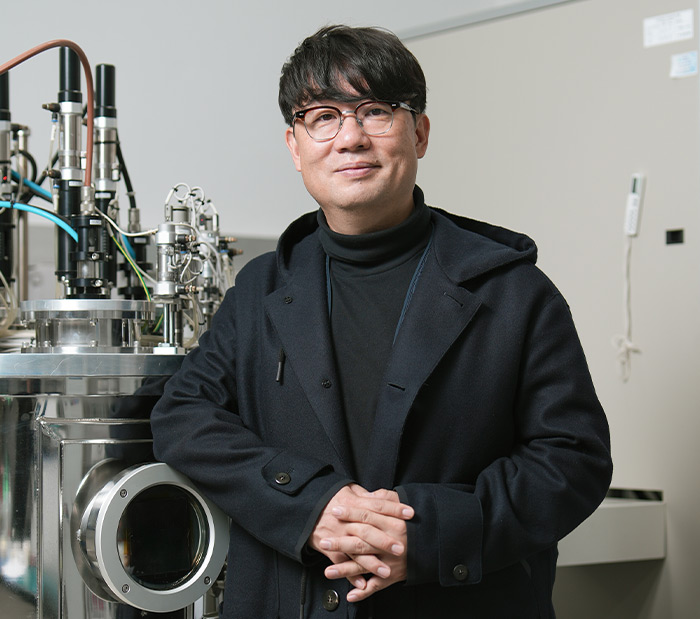Research Stories
Professor Kim Han-Ki's research group has developed specialized low-resistance/high-transparency ITO transparent electro
Securing transparent electrode technology for next-generation large-area high-efficiency perovskite solar cells and ultra-efficient tandem solar cells.
Advanced Materials Science and Engineering
Prof.
KIM, HANKI
Hae-Joon Seok
Sungkyunkwan University announced that Professor Kim Han-Ki's research group in the Department of Advanced Materials Engineering developed specialized ITO transparent electrode technology for the commercialization of next-generation large-area high-efficiency perovskite solar cells.
※Journal: Advanced Energy Materials (Impact factor: 29.698)
Title: Sn composition engineering toward the breakthrough of transparent front electrodes for efficient and stable perovskite solar cells.
※Author names: Han-Ki Kim(Corresponding author), Hae-Joon Seok (1st author)
Overcoming the Problems and Limitations of Previous Research: The existing research on perovskite solar cells faced limitations in achieving maximum efficiency because it relied on commercial ITO transparent electrodes doped with 10 wt.% of Sn, commonly used in displays or basic solar cells, without dedicated transparent electrodes. Research on the Sn dopant content, taking into account the characteristics of the perovskite solar cell's active layer and buffer layer, had not been conducted. Consequently, most studies utilized ITO electrodes intended for display purposes. Professor Kim Han-Ki's research group addressed this by implementing co-sputtering processes to finely control the Sn dopant content and introducing rapid thermal annealing using light to achieve the world's first dedicated ITO transparent electrode specialized for perovskite solar cells.
Named CE-ITO (Composition Engineered ITO), this perovskite solar cell-dedicated transparent electrode exhibited a low sheet resistance of 2.75 Ohm/square and 94% optical transmittance. The developed technology allows for a significant enhancement in perovskite solar cell efficiency, increasing it from 20.78% (with a typical ITO electrode) to 23.35% (with CE-ITO electrode). Additionally, perovskite solar cells manufactured with CE-ITO electrodes demonstrated superior stability compared to those produced with conventional ITO, securing a key technology for the commercialization of next-generation perovskite solar cells.
While most research teams focused on improving efficiency through studies on the active layer or buffer layer of perovskite solar cells, Professor Kim Han-Ki's group took a novel approach by significantly enhancing the characteristics of the transparent electrode. The outstanding electrical/optical properties and stability of the CE-ITO electrode developed by Professor Kim Han-Ki's research group are attributed to precise control of the Sn dopant content, considering the energy band of the perovskite active layer, and crystallization technology facilitated by rapid thermal annealing. The team explains that this not only enhances the interfacial properties of the perovskite solar cell's layered structure but also improves the crystallinity of the layer deposited on top of it, demonstrating an overall improvement in the device's performance.
These research results are expected to advance the research and commercialization of perovskite solar cells by providing crucial electrode technology. It is anticipated that this technology will accelerate the commercialization of semi-transparent perovskite solar cells and ultra-efficient tandem solar cells. Moreover, the application of CE-ITO technology is expected to be viable for ensuring the stability of next-generation high-efficiency solar cells for space applications.
Author's Comment: Through a paradigm shift, our research team has developed a technology that significantly enhances the characteristics of ITO transparent electrodes, which is not commonly studied, unlike the research on the active layer or buffer layer materials. This innovation aims to maximize the efficiency of next-generation perovskite solar cells. The CE-ITO technology developed by our research team is not only applicable to perovskite solar cells but can also be applied to inorganic displays, OLEDs, smart windows, touch panels, biosensors, and transparent electronic components. Therefore, we anticipate that this core technology can dramatically improve the characteristics of next-generation optoelectronic devices through the replacement of electrodes.
The CE-ITO technology is being prepared for mass production as a test element group (TEG) product for research purposes through Professor Kim Han-Ki's laboratory startup company, Coconutmaterials (http://www.coconutmaterials.com). It is expected to be supplied to universities, research institutes, and companies engaged in perovskite solar cell research.
Research support and Publication: This research was conducted with the support of the Ministry of Science and ICT's Research Material Development Diffusion Project and the Gyeonggi Regional Research Center (GRRC). This research was published in the international scientific journal Advanced Energy Materials (IF: 29.698) on December 10th.
Flexible CEITO thin film deposited on UTG (Ultra Thin Glass)
Comparison of the interface of perovskite solar cells fabricated on conventional ITO and CEITO
Adv. Energy. Mater. (2023)


